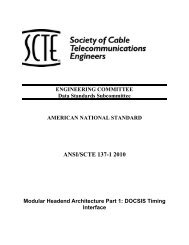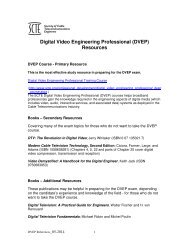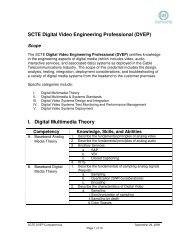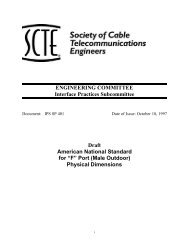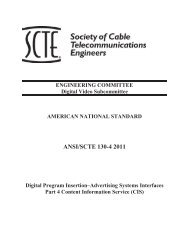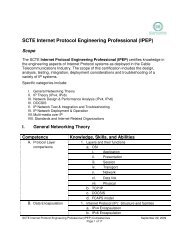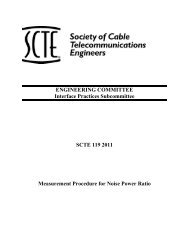SCTE IPS Template, Rev 2
SCTE IPS Template, Rev 2
SCTE IPS Template, Rev 2
- No tags were found...
You also want an ePaper? Increase the reach of your titles
YUMPU automatically turns print PDFs into web optimized ePapers that Google loves.
Further discussion of each of these detection methods is carried out in some detail inANSI/<strong>SCTE</strong> 96 2007. As pointed out in that document, each of these methods has differentperformance levels when detection of (sinusoidal) signals is required in the presence of noise.There is, however, one other issue of AM demodulation that is of importance when detectingAM in the presence of PM. It is a fact that the various methods of detection can give widelyvarying measurement results, if the PM is present in significant magnitude. In general, anymeans of (analog) ‘peak detection’ of the carrier envelope will be more susceptible to phasevariations of the carrier frequency than would the method of analog multiplication. This isbecause ‘peak detection’ methods rely on ‘uniform sampling’ of the peak carrier amplitudes (e.g.the phase at which the carrier peak amplitude occurs, needs to be kept constant). Any timedifference between the occurrences of the peaks of the carrier amplitude, result in a distortion ofthe envelope signal. The ‘analog multiplication’ method inherently reduces (i.e. theoreticallyeliminates) the phase dependence, due to its ‘synchronous nature’. Therefore, if these phasevariations are of a time dependent nature, so will be the measurements. Many times thesevariations can be ‘smoothed out’ by the process of averaging, carried out in the postdemodulationprocess. Perhaps the biggest advantage of the SQL detector is that it provides thebest immunity from phase effects; that is, it provides the best immunity from the effects of PM-XMOD on the accurate detection of AM-XMOD.Post-demodulation processing of the (AM-XMOD) sideband energy can also be accomplished ina variety of ways, all of which can be thought of as a ‘detection process’ itself. The most simpleand common method is ‘Averaging’. This process can easily be achieved using analog circuit ordigital computation methods, depending upon how the demodulated signal energy is formatted(i.e. whether it is discrete data obtained from a digital sampling, or if it is a continuous signalobtained from analog signal processing). In either case, Averaging does not provide the bestmeans of post processing the sideband energy. A superior method, which often provides the bestdynamic range and resolution of the sideband spectral energy, is the method of ‘Fast FourierTransform’ processing. This is a basic digital sampling method, whereby the Spectral Density ofthe AM-XMOD is analyzed by computational means: the sampled data is used in a digitalcomputation of the Spectral Density of the AM-XMOD. Since the sampling is carried out onsignals of low frequencies (i.e. ‘baseband’), sampling speeds can easily be chosen as high as fivetimes the required Nyquist rate and as high as 12 bits per sample (or more) can be used with noloss in sampling fidelity. An instrument that can carry out this function is many times termed a‘Baseband (Spectrum) Analyzer’, and is readily available as a piece of test equipment.As the final topic, PM-XMOD effects on the measurement are as follows:28



